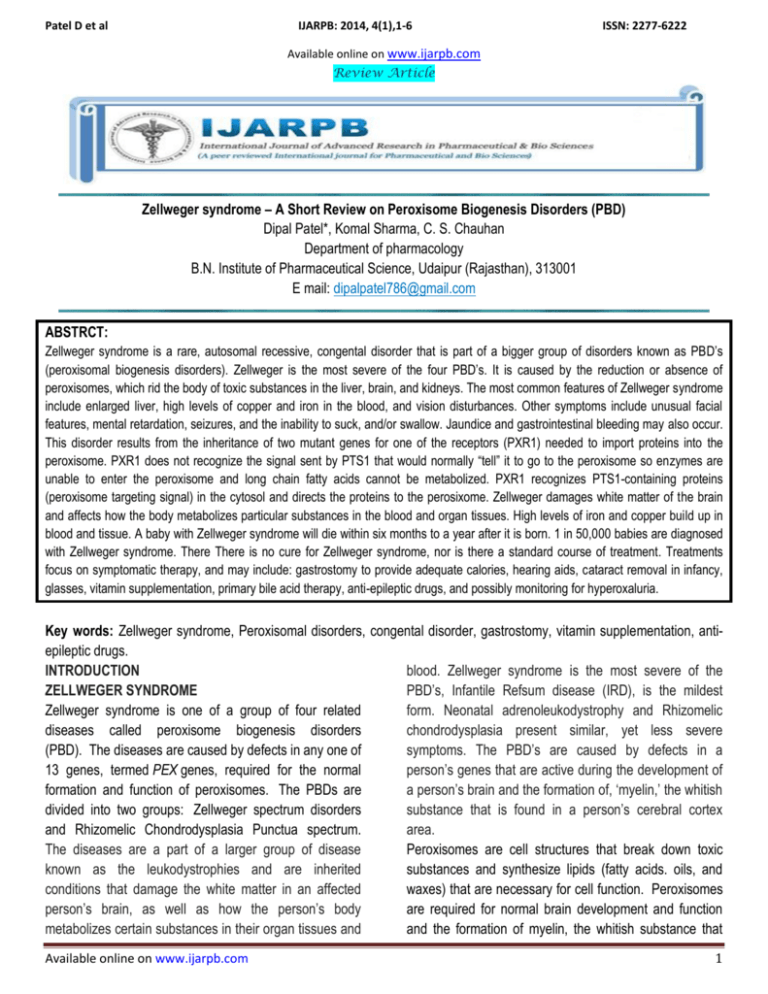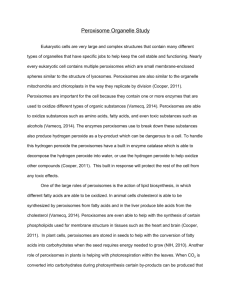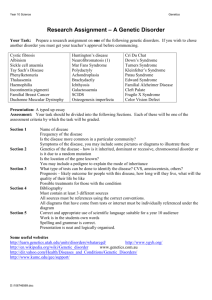Zellweger syndrome – A Short Review on Peroxisome
advertisement

Patel D et al IJARPB: 2014, 4(1),1-6 ISSN: 2277-6222 Available online on www.ijarpb.com Review Article Zellweger syndrome – A Short Review on Peroxisome Biogenesis Disorders (PBD) Dipal Patel*, Komal Sharma, C. S. Chauhan Department of pharmacology B.N. Institute of Pharmaceutical Science, Udaipur (Rajasthan), 313001 E mail: dipalpatel786@gmail.com ABSTRCT: Zellweger syndrome is a rare, autosomal recessive, congental disorder that is part of a bigger group of disorders known as PBD’s (peroxisomal biogenesis disorders). Zellweger is the most severe of the four PBD’s. It is caused by the reduction or absence of peroxisomes, which rid the body of toxic substances in the liver, brain, and kidneys. The most common features of Zellweger syndrome include enlarged liver, high levels of copper and iron in the blood, and vision disturbances. Other symptoms include unusual facial features, mental retardation, seizures, and the inability to suck, and/or swallow. Jaundice and gastrointestinal bleeding may also occur. This disorder results from the inheritance of two mutant genes for one of the receptors (PXR1) needed to import proteins into the peroxisome. PXR1 does not recognize the signal sent by PTS1 that would normally “tell” it to go to the peroxisome so enzymes are unable to enter the peroxisome and long chain fatty acids cannot be metabolized. PXR1 recognizes PTS1-containing proteins (peroxisome targeting signal) in the cytosol and directs the proteins to the perosixome. Zellweger damages white matter of the brain and affects how the body metabolizes particular substances in the blood and organ tissues. High levels of iron and copper build up in blood and tissue. A baby with Zellweger syndrome will die within six months to a year after it is born. 1 in 50,000 babies are diagnosed with Zellweger syndrome. There There is no cure for Zellweger syndrome, nor is there a standard course of treatment. Treatments focus on symptomatic therapy, and may include: gastrostomy to provide adequate calories, hearing aids, cataract removal in infancy, glasses, vitamin supplementation, primary bile acid therapy, anti-epileptic drugs, and possibly monitoring for hyperoxaluria. Key words: Zellweger syndrome, Peroxisomal disorders, congental disorder, gastrostomy, vitamin supplementation, antiepileptic drugs. INTRODUCTION blood. Zellweger syndrome is the most severe of the ZELLWEGER SYNDROME PBD’s, Infantile Refsum disease (IRD), is the mildest Zellweger syndrome is one of a group of four related form. Neonatal adrenoleukodystrophy and Rhizomelic diseases called peroxisome biogenesis disorders chondrodysplasia present similar, yet less severe (PBD). The diseases are caused by defects in any one of symptoms. The PBD’s are caused by defects in a 13 genes, termed PEX genes, required for the normal person’s genes that are active during the development of formation and function of peroxisomes. The PBDs are a person’s brain and the formation of, ‘myelin,’ the whitish divided into two groups: Zellweger spectrum disorders substance that is found in a person’s cerebral cortex and Rhizomelic Chondrodysplasia Punctua spectrum. area. The diseases are a part of a larger group of disease Peroxisomes are cell structures that break down toxic known as the leukodystrophies and are inherited substances and synthesize lipids (fatty acids. oils, and conditions that damage the white matter in an affected waxes) that are necessary for cell function. Peroxisomes person’s brain, as well as how the person’s body are required for normal brain development and function metabolizes certain substances in their organ tissues and and the formation of myelin, the whitish substance that Available online on www.ijarpb.com 1 Patel D et al IJARPB: 2014, 4(1),1-6 coats nerve fibers. They are also required for normal eye, liver, kidney, and bone functions. Zellweger spectrum disorders result from dysfunctional lipid metabolism, including the over-accumulation of very longchain fatty acids and phytanic acid, and defects of bile acids and plasmalogens--specialized lipids found in cell membranes and myelin sheaths of nerve fibers. Symptoms of these disorders include an enlarged liver; characteristic facial features such as a high forehead, underdeveloped eyebrow ridges, and wide-set eyes; and neurological abnormalities such as mental retardation and seizures. Infants will Zellweger syndrome also lack muscle tone, sometimes to the point of being unable to move, and may not be able to suck or swallow. Some babies will be born with glaucoma, retinal degeneration, and impaired hearing. Jaundice and gastrointestinal bleeding also may occur. Once a person with Zellweger syndrome has been born, defects in the their genes either reduce or entirely eliminate the presence of, ‘peroxisomes,’ or cell structures that break down toxic substances in the cells of their kidneys, liver and brain. The result is high-levels of copper and iron that build up in their blood and tissue, causing the symptoms that are characteristic of the disease. Zellweger syndrome is also known by the following names: * Generalized Peroxisomal Disorders * Peroxisomal Biogenesis Disorders * Zellweger Syndrome Spectrum * ZSS * cerebrohepatorenal syndrome CAUSES OF ZELLWEGER SYNDROME Mutations in one of a number of genes are the cause of Zellweger syndrome; they lead to a dysfunctional protein that is important for a person’s cells to be able to import newly-synthesized proteins into small cytoplasmic organelles called, ‘peroxisomes.’ Zellweger syndrome is characterized by either a reduction in, or the complete absence of, peroxisomes. There are key enzymes which are critical for different chemical reactions, particularly oxidation, that are contained within peroxisomes.Structural and functional abnormalities of Available online on www.ijarpb.com ISSN: 2277-6222 peroxisomes can lead to disease development observed in Zellweger syndrome. Peroxisomes are usually abundant in a person’s kidney and liver; their lack leaves the organs of persons with Zellweger syndrome affected by the disease. Toxic molecules that enter the person’s bloodstream fail to be detoxified because of a lack of peroxisomes, although there are additional mechanisms for detoxification. Peroxisomes may also function in the organic creation of key compounds and play important roles related to different chemical reactions in a person’s body. The mutations in a number of genes and Zellweger syndrome that affect the function of peroxisome include peroxin-1 (PEX1), peroxin-2 (PEX2) peroxin-3 (PEX3), peroxin-5 (PEX5), peroxin-6 (PEX6), and peroxin-12 (PEX12). Each of these gene locations are genetically and biochemically unique and found on different chromosomes. SYMPTOMS OF ZELLWEGER SYNDROME There are a number of observable, clinical features associated with Zellweger syndrome. These symptoms can include facial, developmental, as well as eye defects. Features that are characteristic of the syndrome include upslanting eyes, a high forehead, and ‘epicanthal,’ or skin folds along the person’s nasal borders of the space between the upper and lower eyelids of their eyes. Babies with Zellweger syndrome commonly experience a loss of muscle tone, severe weakness, and many times experience seizure activity. Many also have severe ocular (eye) abnormalities that may affect their vision. The symptoms of Zellweger syndrome can include: * Seizures * Jaundice * Elevated iron * Enlarged liver * Elevated copper * Inability to move * Poor sucking ability * Vision disturbances * Lack of muscle tone * Difficulty swallowing * Intellectual Disability * Prenatal growth failure * Gastrointestinal bleeding * Characteristic facial characteristics 2 Patel D et al IJARPB: 2014, 4(1),1-6 ISSN: 2277-6222 Baby with Zellweger syndrome The more common features of Zellweger syndrome Other symptoms may include unusual facial involve enlargement of the person’s liver, vision issues, characteristics, mental retardation, seizures, and an as well as increased levels of both copper and iron in inability to suck and/or swallow. Jaundice and their blood. Some infants with the syndrome experience gastrointestinal bleeding may also occur. prenatal growth failure. Symptoms that may be present at MOLECULAR BASIS OF DISEASE birth include a lack of muscle tone and an inability to Zellweger syndrome is an autosomal recessive disorder move. Additional symptoms related to the syndrome may caused by mutations in genes that encode peroxins, include intellectual disability, characteristic facial features, proteins required for the normal assembly an inability to suck or swallow, jaundice, and of peroxisomes. Most commonly, patients have mutations gastrointestinal bleeding. in The most common features of Zellweger syndrome the PEX1,PEX2, PEX3, PEX5, PEX6, PEX10, PEX12, P include an enlarged liver, high levels of iron and copper in EX13, PEX14, PEX16, PEX19,and PEX26 genes. In the blood, and vision disturbances. Some affected infants almost all cases, patients have mutations that inactivate may show prenatal growth failure. Symptoms at birth may or greatly reduce the activity of both the maternal and include lack of muscle tone and an inability to move. paternal copies of one these aforementioned PEX genes. Molecular conditions leading to Zellweger-like syndromes in human and mouse. PEXn = any of the peroxisome biogenesis proteins that can be mutated in classical Zellweger syndrome. MFP1/2 = multifunctional proteins of peroxisomal beta-oxidation. DHAPAT = dihydroxyacetone Available online on www.ijarpb.com phosphate acyl transferase. VLCFAs = very long-chain fatty acids. DHA = docosahexaenoic acid. As a result of impaired peroxisome function, an individual's tissues and cells can accumulate very long chain fatty acids (VLCFA) and branched chain fatty acids (BCFA) that are normally degraded in peroxisomes. The 3 Patel D et al IJARPB: 2014, 4(1),1-6 accumulation of these lipids can impair the normal function of multiple organ systems, as discussed below. In addition, these individuals can show deficient levels of plasmalogens, ether-phospholipids that are especially important for brain and lung function. CLINICAL MANIFESTATIONS OF DISEASE Zellweger syndrome is one of three peroxisome biogenesis disorders which belong to the Zellweger spectrum of peroxisome biogenesis disorders (PBDZSD). The other two disorders are neonatal adrenoleukodystrophy(NALD), and infantile Refsum disease (IRD). Although all have a similar molecular basis for disease, Zellweger syndrome is the most severe of these three disorders. Zellweger syndrome is associated with impaired neuronal migration, neuronal positioning, and brain development. In addition, individuals with Zellweger syndrome can show a reduction in central nervous system (CNS)myelin (particularly cerebral), which is referred to as hypomyelination. Myelin is critical for normal CNS functions and, in this regard, serves to insulate nerve fibers in the brain. Patients can also show postdevelopmental sensorineuronal degeneration that leads to a progressive loss of hearing and vision. Zellweger syndrome can also affect the function of many other organ systems. Patients can show craniofacial abnormalities (such as a high forehead, hypoplastic supraorbital ridges, epicanthal folds, midface hypoplasia, and a large fontanel), hepatomegaly (enlarged liver), chondrodysplasia punctata (punctate calcification of the cartilage in specific regions of the body), eye abnormalities, and renal cysts. Newborns may present with profoundhypotonia (low muscle tone), seizures, apnea, and an inability to eat. MOLECULAR DIAGNOSTICS In addition to genetic tests involving the sequencing of PEX genes, biochemical tests have proven highly effective for the diagnosis of Zellweger syndrome and other peroxisomal disorders. Typically, Zellweger syndrome patients show elevated very long chain fatty acids in their blood plasma. Cultured primarily skin fibroblasts obtained from patients show elevated very Available online on www.ijarpb.com ISSN: 2277-6222 long chain fatty acids, impaired very long chain fatty acid beta-oxidation, phytanic acid alphaoxidation, pristanic acid alpha-oxidation, and plasmalogen biosynthesis. DIAGNOSING ZELLWEGER SYNDROME The absence of peroxisomes in persons with Zellweger syndrome was initially demonstrated by American pathologist S.L. Goldfischer in the year 1985. The absence of these organelles in affected person’s livers is now thought to be the hallmark of the disorder. Persons with Zellweger syndrome have been found to present with noticeably fewer peroxisomes in their brain and in cultured skin fibroblasts. ‘Fibroblasts,’ are a type of skin cell; in Zellweger syndrome these cells appear to have, ‘ghost-like,’ peroxisomes, caused by the absence of particular proteins inside the organelles that are recruited into the membranes. Peroxisomes play a crucial role in organ development. Brain abnormalities may be explained by the disrupted migration of, ‘neurons,’ or nerve cells, around the third month of gestation. There is a defect that occurs in a particular area of a person’s brain called the, ‘cerebrum,’ that leads to small or thick convolutions in the person’s brain tissue. The brain abnormality permits Zellweger syndrome to be identified and distinguished from other diseases involving brain abnormalities. Additional tissues that are involved in the syndrome include the person’s kidney, liver, heart, cartilage, and muscle. The majority of persons with Zellweger syndrome have cysts on their kidneys. A diagnosis of Zellweger syndrome can be reached by measuring the metabolic compounds in the person’s blood samples. Various plasmalogens, fatty acids, bile acid intermediates, and pipecolic acid are commonly studied. Other than diminished levels of plasmologen, the compounds in the person’s blood are commonly increased in persons affected by Zellweger syndrome. Another possibility is to detect plasmologen synthesis and fatty acid levels prior to the person’s birth through obtaining cells in the fluid of the amnion, something referred to as, ‘amniocentesis.’ Pregnant mothers who have had a baby that was previously affected by 4 Patel D et al IJARPB: 2014, 4(1),1-6 Zellweger syndrome can choose to have a prenatal diagnosis in order to determine if their child is affected by the syndrome. TREATMENT OF ZELLWEGER SYNDROME Medical science has not discovered a cure for Zellweger syndrome at this time, and there is no standard course of treatment for this syndrome. Zellweger syndrome and the neurological and metabolic abnormalities associated with it, are caused during fetal development. Treatments to correct them after a person is born are limited; the majority of treatment options are supportive and symptomatic. Treatments focus on symptomatic therapy, and may include: gastrostomy to provide adequate calories, hearing aids, cataract removal in infancy, glasses, vitamin supplementation, primary bile acid therapy, anti-epileptic drugs, and possibly monitoring for hyperoxaluria. The prognosis for infants with Zellweger syndrome is poor, with the majority of infants failing to survive their first six months of life; they usually die from gastrointestinal bleeding, respiratory distress, or liver failure. People with Zellweger syndrome often do not live more than a year after they are diagnosed. Because of this, genetic counseling and prenatal diagnosis are commonly given high-priority for parents who are either identified or concerned that they might be at risk of having a child with Zellweger syndrome. REFERENCES: 1) Brul, S.; Westerveld, A.; Strijland, A.; Wanders, R.; Schram, A.; Heymans, H.; Schutgens, R.; Van Den Bosch, H.; Tager, J. (June 1988). "Genetic heterogeneity in the cerebrohepatorenal (Zellweger) syndrome and other inherited disorders with a generalized impairment of peroxisomal functions. A study using complementation analysis". Journal of Clinical Investigation (Free full text) 81 (6): 1710–1715. Available online on www.ijarpb.com ISSN: 2277-6222 2) Wiedemann, H. R. (1991). "Hans-Ulrich Zellweger (1909-1990)". European journal of pediatrics 150 (7): 451–451. 3) Steinberg, S.; Dodt, G.; Raymond, G.; Braverman, N.; Moser, A.; Moser, H. (2006). "Peroxisome biogenesis disorders". Biochimica et Biophysica Acta (BBA) - Molecular Cell Research 1763 (12): 1733. 4) Krause, C.; Rosewich, H.; Thanos, M.; Gärtner, J. (2006). "Identification of novel mutations inPEX2,PEX6,PEX10,PEX12, andPEX13in Zellweger spectrum patients". Human Mutation 27 (11): 1157 5) Raymond, G. V.; Watkins, P.; Steinberg, S.; Powers, J. (2009). "Peroxisomal Disorders". Handbook of Neurochemistry and Molecular Neurobiology. pp. 631–670. 6) Steinberg, S.; Chen, L.; Wei, L.; Moser, A.; Moser, H.; Cutting, G.; Braverman, N. (2004). "The PEX Gene Screen: molecular diagnosis of peroxisome biogenesis disorders in the Zellweger syndrome spectrum". Molecular Genetics and Metabolism 83 (3): 252–263. 7) Yik, W. Y.; Steinberg, S. J.; Moser, A. B.; Moser, H. W.; Hacia, J. G. (2009). "Identification of novel mutations and sequence variation in the Zellweger syndrome spectrum of peroxisome biogenesis disorders". Human Mutation 30 (3): E467–E480. 8) http://www.nu-mega.com/content/?id=24 9) http://rarediseases.about.com/od/rarediseasesz/a /030505.htm 10) http://www.ninds.nih.gov/disorders/zellweger/zell weger.htm#What research is being done 11) http://www.ncbi.nlm.nih.gov/bookshelf/br.fcgi?bo ok=gene&part=pbd 12) http://ghr.nlm.nih.gov/condition/zellwegerspectrum. 13) http://en.wikipedia.org/w/index.php?title=Zellweg er_syndrome&oldid=541403518 5







